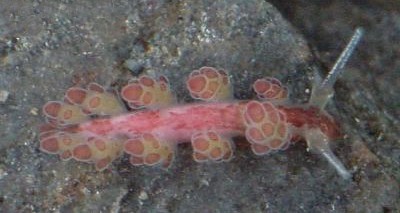
Doto floridicola
Simroth, 1888
Order: NUDIBRANCHIA
Suborder: DENDRONOTINA
Family: Dotidae
DISTRIBUTION
Azores, Mediterranean.
PHOTO
Cerbere, France [Mediterranean coast]. July 03, 2002. Length: 7-8mm. Photo: Marina Poddubetskaia
The rhinophores are smooth and slender and the rhinophore sheaths are only slightly expanded at the top. The cerata are elongate and inflated with two rows of tubercles and a larger rounded one at the tip. The background colour of the body is a dull yellow. The tips of the tubercles are covered with a dull red spot and their are similarly coloured small spots on the oral veil, and forming a median band dwon the dorsum and on the sides of the body. The red pigmentation is absent from the base of the cerata and between the cerata. The rhinophores are translucent clear with two opaque white lines, one down the posterior side and one down the anterior. In some cases the red pigmentation is replaced by brown. Grows to about 10mm. This species has some similarities to Doto paulinae Trinchese, 1881, but the most distincrtive difference is that in that species the terminal ceratal tubercle is white not red.
Originally described from the Azores, it has subsequently been recorded from various places in the western Mediterranean, and as far east as the Aegean Sea.
References:
• Schmekel, L. & Kress, A (1977) Die Gattung Doto (Gastropoda: Nudibranchia) im Mittelmeer und Armelkanal, mit beschreibung von Doto acuta n. sp. Malacologia, 16(2): 467-499.
• Schmekel, L. & Portmann, A (1982) Opisthobranchia des Mittelmeeres, Nudibranchia und Saccoglossa. Fauna e Flora del Golfo Napoli, 40: 1-410. Springer-Verlag: Berlin
• Thompson, T.E., Cattaneo, R. & Wong, Y.M. (1990). Eastern Mediterranean opisthobranchia: Dotidae (Dendronotoidea), Arminidae and Madrellidae (Arminoidea). Journal of Molluscan Research, 56: 393-413
Rudman, W.B., 2002 (July 25) Doto floridicola Simroth, 1888. [In] Sea Slug Forum. Australian Museum, Sydney. Available from http://www.seaslugforum.net/find/dotoflor
Related messages
Doto floridicola from French Mediterranean
June 26, 2007
From: Sylvain Le Bris
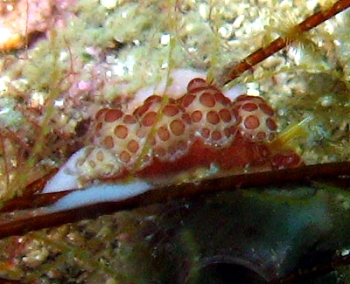
Dear Bill
I took this picture in Tiboulen du Frioul, Marseille, France, Mediterranean sea. I am sorry for the bad quality of the picture. I think it is Doto floridicola. It was 7 mm long and was laying its eggs on Hydrozoans
Locality: Tiboulen du Frioul, Marseille, 30m, France, Mediterranean, 17 June 2007. Length: 7mm. Photographer: Sylvain Le Bris.
Best regards
Sylvain Le Bris
sylvain.lebris@freesbee.fr
Le Bris, S., 2007 (Jun 26) Doto floridicola from French Mediterranean. [Message in] Sea Slug Forum. Australian Museum, Sydney. Available from http://www.seaslugforum.net/find/20070Thanks Sylvain,
Yes this is Doto floridicola.
Best wishes,
Bill Rudman
Doto floridicola from Turkey
June 5, 2003
From: Haluk Akbatur
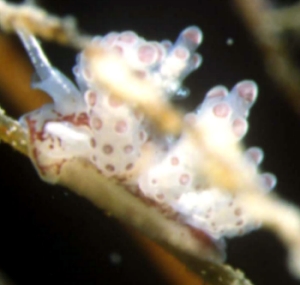
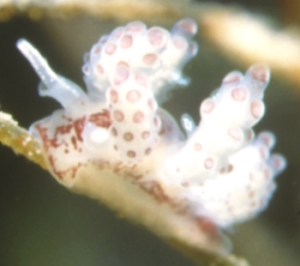
Dear Bill,
Two weeks ago I found, what I believe is a new species of nudi for the Turkey. It was 2 to 4 mm long, at 32 m. depth on a grass-sandy bottom. Water temperature 16 deg. C. I took pictures, but it was very small. It is white, with brown-purple dots at the tip of ceratas. So, its body looks like Doto sp. or Eubranchus spp.?
Dive place: Uc adalar (South-west of Turkey, Mediterranean) Depth: 32m; Size: 4 mm. May, 11 2003
Thanks for any help in identifying this species.
H. Haluk Akbatur
lasergoz@ttnet.net.tr
Akbatur, H. , 2003 (Jun 5) Doto floridicola from Turkey. [Message in] Sea Slug Forum. Australian Museum, Sydney. Available from http://www.seaslugforum.net/find/10134Dear Haluk,
Although some species of Eubranchus can have rounded papillae on the cerata, one easy way to separate them from species of Doto is to look at the rhinophores. Species of Doto, like all dendronotoideans, have the rhinophore enclosed in a sheath. If you look at your photos you can clearly see the sheath [or raised tube] whih partially encloses the rhinophore.
This is Doto floridicola. Thompson, et al (1990), report it from the Saronic Gulf, in Greece, but I don't know of a record as far east in the Mediterranean as Turkey.
• Thompson, T.E., Cattaneo, R. & Wong, Y.M. (1990). Eastern Mediterranean opisthobranchia: Dotidae (Dendronotoidea), Arminidae and Madrellidae (Arminoidea). Journal of Molluscan Research, 56: 393-413
Best wishes,
Bill Rudman
Re: Doto floridicola from British Isles
August 1, 2002
From: Bernard Picton
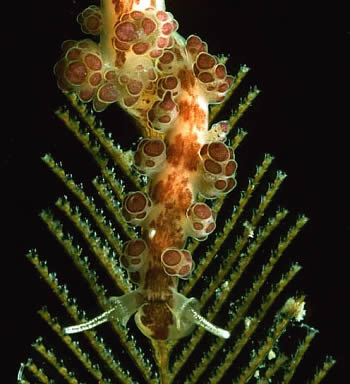
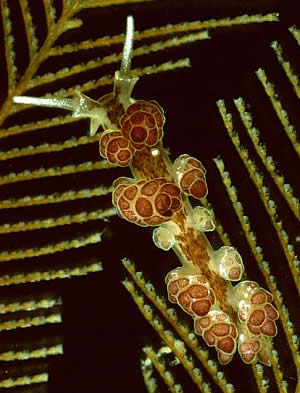
Hi Bill,
It's nice to see Marina's photos of Doto floridicola as I've been wondering if this was what I've been finding around our SW coasts. This year I saw animals on the Costa Brava which are certainly the same as the one we called Doto sp.A in our book and I'm now convinced that it must be Doto floridicola. I first saw this species at Skomer Island, Wales in June 1990, then at the Blasket Is., Co Kerry, SW Ireland in July 1990 and not since until this year, when I found it on the Aran Is., Co. Galway in June 2002.
My observations are that Doto floridicola is only found on Aglaophenia kirchenpaueri. On Aglaophenia tubulifera we get Doto lemchei, which is similar in size and proportions but quite different in pigmentation. On Aglaophenia pluma we get Doto koenneckeri, which grows a bit larger and has black spots on the ceratal tubercles like most of the other Doto species in this part of the world.
These Doto species are very closely associated with their hydroid food, and in my observations seem to stay hidden at the base of the food most of the time, apparently drilling a small hole in the rhizoidal tissue and feeding suctorially on the hydroid coenosarc through this hole. Occasionally they will drill the main stem of the hydroid but they don't seem to eat the polyps at all. They climb the stems to spawn, so the spawn coils are a good clue that a clump of hydroid is being attacked by Dotos.
The Doto radula is unusual in that the teeth are not symmetrical, they are alternately right-handed and left-handed, like the teeth on a saw.
Upper Image - Doto floridicola - Blasket Is., Co Kerry, Ireland - July 1990
Lower Image - Doto floridicola - Inishmore, Aran Is., Galway, Ireland - June 2002
Bernard
bernard.picton.um@nics.gov.uk
Picton, B. , 2002 (Aug 1) Re: Doto floridicola from British Isles. [Message in] Sea Slug Forum. Australian Museum, Sydney. Available from http://www.seaslugforum.net/find/7673Thanks Bernard,
Bill Rudman
Doto floridicola from French Mediterranean
July 31, 2002
From: Patrick Heurtaux
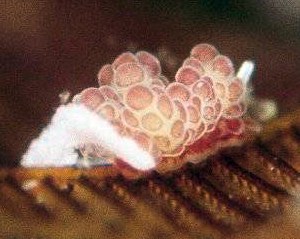
Dear Bill,
Here are two photos of Doto floridicola, I took in the Baie de Peyrefitte (near the mediterranean French/Spanish border), in 3m deep, in June.
The first was 3mm long and was laying its eggs on Aglaophenia sp. The second was 4mm long and I have include my finger in the pic to give a good representation of the real size of the Doto.
Best regards.
Patrick Heurtaux
pheurtau@club-internet.fr
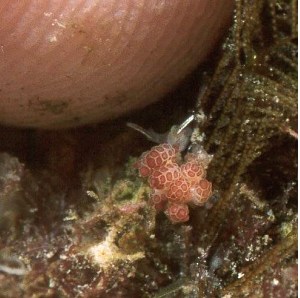
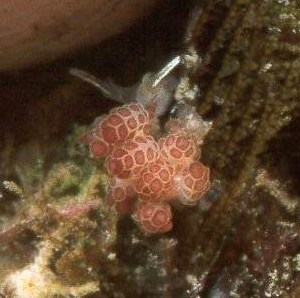
Thanks Patrick,
There are few illustrations of this species available so it's nice to get your photos showing it on its food hydroid.
Best wishes,
Bill Rudman
Doto floridicola from French Mediterranean
July 27, 2002
From: Marina Poddubetskaia

Dear Bill,
Could you confirm, please, the ID of this Doto floridicola Simroth, 1888. Usually, this animal and its egg-ribbon could be found on Aglaophenia spp.
Date: July 03, 2002
Location: Cerbere, France [Mediterranean coast]. Site: Canadells
Size: animal = 7-8mm / egg-ribbon = 5-6mm
Photos: Marina Poddubetskaia - Nembro website
Best wishes,
Marina.
nembro@nembro.info
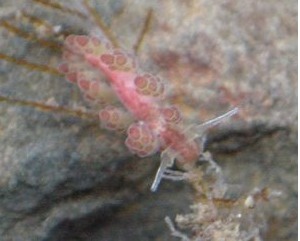
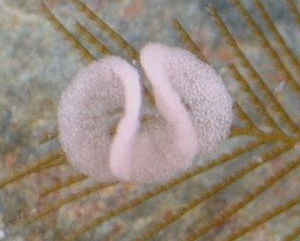
Dear Marina,
It certainly looks like D. floridicola. Another species with similar reddish markings is D. paulinae Trinchese, 1881 but in that species the terminal ceratal tubercle is white not red.
Best wishes,
Bill Rudman
